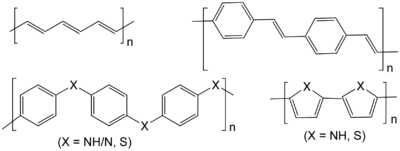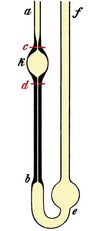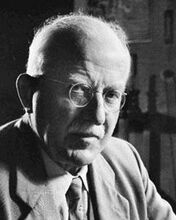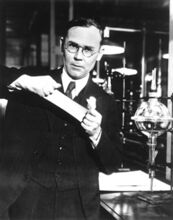كيمياء الپوليمرات

كيمياء الپوليمرات أو كيمياء الجزيئات الكبيرة علم متشعب يتعامل مع التصنيع الكيميائي والخواص الكيميائي للبوليمرات أو الجزيئات الكبيرة. الجزيئات الكبيرة بصفة عامة ترجع إلى سلاسل جزيئية وبالتالي فإنها تتبع علم الكيمياء. البوليمرات تصف خواص أغلبية مادة البوليمروتتبع علم فيزياء البوليمرات كعلم متفرع من الفيزياء. اللدائن مثل البولي إثيلين يعامل في هذه المقالة على أنها تفرع من البوليمرات التصنيعية التى لها شهرة تجارية. البوليمرات الحيوية مثل البروتينات هى أيضا تفرع للبوليمرات وتتواجد في الطبيعة.
يتم عمل البوليمرات عن طريق بلمرة المونومرات. ويتم وصف البوليمر كيميائيا بدرجة البلمرة، توزيع الكتلة المولية, الإنتظامية, توزيع البوليمر التساهمي, تفرع البوليمر, مجموعة نهاية, تشابك, تبللر, وأيضا بالخواص الحرارية مثل درجة الإنتقال الزجاجية. البوليمرات في المحاليل لها خواص خاصة بالنظر إلى ذوبانيته, كثافته, تكتله.[1][2][3][4]
تاريخ البوليمرات
The work of Henri Braconnot in 1777 and the work of Christian Schönbein in 1846 led to the discovery of nitrocellulose, which, when treated with camphor produced celluloid. Dissolved in ether or acetone, it is collodion, used as a wound dressing since the U.S. Civil War. Cellulose acetate was first prepared in 1865. In 1834, Friedrich Ludersdorf and Nathaniel Hayward independently discovered that adding sulfur to raw natural rubber (polyisoprene) helped prevent the material from becoming sticky. In 1844 Charles Goodyear received a U.S. patent for vulcanizing rubber with sulfur and heat. Thomas Hancock had received a patent for the same process in the UK the year before.
فى عام 1897 قام هيلاري دى شاردونيه ببدء أول مصنع لتصنيع الخيوط بناءا على السليولوز كمادة لإستبدال الحرير، إلا أنه كان سريع الاشتعال.[5] في عام 1907 قام ليو بيكيلاند باختراع أول بوليمر تصنيعي، راتنج الفينول-فورمالدهايد المسمى باكلايت. Around the same time, Hermann Leuchs reported the synthesis of amino acid N-carboxyanhydrides and their high molecular weight products upon reaction with nucleophiles, but stopped short of referring to these as polymers, possibly due to the strong views espoused by Emil Fischer, his direct supervisor, denying the possibility of any covalent molecule exceeding 6,000 daltons.[6] Cellophane was invented in 1908 by Jocques Brandenberger who treated sheets of viscose rayon with acid.[7]
- Leading figures in polymer chemistry
Hermann Staudinger, father of polymer chemistry
Wallace Carothers, inventor of nylon.
Stephanie Kwolek, inventor of Kevlar.


وفي عام 1922 كان هرمان شتاودنگر (من ڤورمز بألمانيا) كان أول من اقترح أن البوليمرات تتكون من سلاسل طويلة من الذرات مرتبطة معا برابطة تساهمية. كما اقترح أيضا تسمية هذه المركبات بالجزيئات الكبيرة. وقبل هذا، كان العلماء يعتقدون أن البوليمرات هي تجمعات للجزيئات الصغيرة (تسمي غروانيات) مرتبطة معا عن طريق قوى دقيقة غير معروفة. وقد حصل شتاودينجر على جائزة نوبل في الكيمياء عام 1953. وقد اخترع والاس كاروثرز أول مطاط تصنيعي نيوبرين عام 1931 والنيلون عام 1935. وحصل پول فلوري على جائزة نوبل في الكيمياء عام 1974 لعمله على شكل اللف العشوائي للبوليمرات. PRI's أخرى تأسست في 1961 على يد رتشارد ستاين في جامعة مساتشوستس، أمهرست، في 1967 على يد Eric Baer في جامعة كيس وسترن رزرڤ، في 1982 في جامعة جنوب المسيسپي، وفي عام 1988 في جامعة أكرون.
Polymers and their properties

Polymers are high molecular mass compounds formed by polymerization of monomers. They are synthesized by the polymerization process and can be modified by the additive of monomers. The additives of monomers change polymers mechanical property, processability, durability and so on. The simple reactive molecule from which the repeating structural units of a polymer are derived is called a monomer. A polymer can be described in many ways: its degree of polymerisation, molar mass distribution, tacticity, copolymer distribution, the degree of branching, by its end-groups, crosslinks, crystallinity and thermal properties such as its glass transition temperature and melting temperature. Polymers in solution have special characteristics with respect to solubility, viscosity, and gelation. Illustrative of the quantitative aspects of polymer chemistry, particular attention is paid to the number-average and weight-average molecular weights and , respectively.
The formation and properties of polymers have been rationalized by many theories including Scheutjens–Fleer theory, Flory–Huggins solution theory, Cossee–Arlman mechanism, Polymer field theory, Hoffman Nucleation Theory, Flory–Stockmayer theory, and many others.

The study of polymer thermodynamics helps improve the material properties of various polymer-based materials such as polystyrene (styrofoam) and polycarbonate. Common improvements include toughening, improving impact resistance, improving biodegradability, and altering a material’s solubility.[8]
اللزوجة
As polymers get longer and their molecular weight increases, their viscosity tend to increase. Thus, the measured viscosity of polymers can provide valuable information about the average length of the polymer, the progress of reactions, and in what ways the polymer branches.[9]
التبويب
Polymers can be classified in many ways. Polymers, strictly speaking, comprise most solid matter: minerals (i.e. most of the Earth's crust) are largely polymers, metals are 3-d polymers, organisms, living and dead, are composed largely of polymers and water. Often polymers are classified according to their origin:

Biopolymers are the structural and functional materials that comprise most of the organic matter in organisms. One major class of biopolymers are proteins, which are derived from amino acids. Polysaccharides, such as cellulose, chitin, and starch, are biopolymers derived from sugars. The polynucleic acids DNA and RNA are derived from phosphorylated sugars with pendant nucleotides that carry genetic information.
Synthetic polymers are the structural materials manifested in plastics, synthetic fibers, paints, building materials, furniture, mechanical parts, and adhesives. Synthetic polymers may be divided into thermoplastic polymers and thermoset plastics. Thermoplastic polymers include polyethylene, teflon, polystyrene, polypropylene, polyester, polyurethane, Poly(methyl methacrylate), polyvinyl chloride, nylons, and rayon. Thermoset plastics include vulcanized rubber, bakelite, Kevlar, and polyepoxide. Almost all synthetic polymers are derived from petrochemicals.
نظريات
Association theory is a discredited theory which tried to explain molecular structures of macromolecules.
Some other theories related to polymers include
- Scheutjens–Fleer theory
- Flory–Huggins solution theory
- Cossee-Arlman mechanism
- Polymer field theory
- Hoffman Nucleation Theory
- Flory-Stockmayer Theory
أمثلة من البوليمرات
البوليمرات الحيوية
They are produced by living organisms:
- structural proteins: collagen, keratin, elastin…
- chemically functional proteins: enzymes, hormones, transport proteins…
- structural polysaccharides: cellulose, chitin…
- storage polysaccharides: starch, glycogen…
- nucleic acids: DNA, RNA
بوليمرات تصنيعية
Examples of Synthetic polymers are plastics, fibers, paints, building materials, furniture, mechanical parts, adhesives:
- thermoplastics: polyethylene, Teflon, polystyrene, polypropylene, polyester, polyurethane, polymethyl methacrylate, polyvinyl chloride, nylon, rayon, celluloid, silicone…
- thermosetting plastics: vulcanized rubber, Bakelite, Kevlar, epoxy…
انظر أيضاً
الهامش
- ^ "The Macrogalleria: A Cyberwonderland of Polymer Fun". www.pslc.ws (in الإنجليزية). Retrieved 2018-08-01.
- ^ Young, R. J. (1987) Introduction to Polymers, Chapman & Hall ISBN 0-412-22170-5
- ^ Odian, George G. Principles of polymerization (Fourth ed.). Hoboken, N.J. ISBN 9780471478751. OCLC 54781987.
- ^ Hans-Heinrich Moretto, Manfred Schulze, Gebhard Wagner (2005) "Silicones" in Ullmann's Encyclopedia of Industrial Chemistry, Wiley-VCH, Weinheim. DOI:10.1002/14356007.a24_057
- ^ "The Early Years of Artificial Fibres". The Plastics Historical Society. Retrieved 2011-09-05.
- ^ Kricheldorf, Hans, R. (2006), "Polypeptides and 100 Years of Chemistry of α-Amino Acid N-Carboxyanhydrides", Angewandte Chemie International Edition 45 (35): 5752–5784, doi:, PMID 16948174
- ^ "History of Cellophane". about.com. Archived from the original on June 29, 2012. Retrieved 2011-09-05.
- ^ X Zhang, X Peng, SW Zhang. “7 - Synthetic biodegradable medical polymers: Polymer blends” Science and Principles of Biodegradable and Bioresorbable Medical Polymers, 2017. 217-254.
- ^ "Viscosity of Polymer Solutions". polymerdatabase.com. Retrieved 2019-03-05.
المصادر
- ويكيبيديا الإنجليزية.






